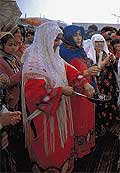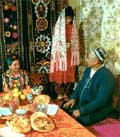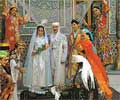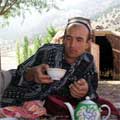Traditions in Uzbekistan
Traveling in Central Asia is a cultural experience with ancient traditions still rooted deeply in everyday life.
Navruz
Navruz (also called Noruz, Nowruz, Nowrooz, and Nawruz), the spring "New Year" holiday, has been celebrated for at least 2,500 years, and perhaps for as long as 5,000 years. Central Asia has its own Navruz traditions. From ancient times, the holiday was celebrated in agricultural oases with festivals, bazaars, horseracing, and dog and cock fights. Today, Uzbeks still serve a traditional meal of "sumalyak", which tastes like molasses-flavored cream of wheat and is made from flour and sprouted wheat grains. Sumalyak is cooked slowly on a wood fire, sometimes with the addition of spices. Sprouted grain is a symbol of life, heat, abundance and health.
The art of hospitality
Through the cities along the Great Silk Road, such as Naryn, Bukhara, Samarkand and Khiva, passed hundreds and thousands of tradesmen and the many helpers who accompanied the caravans of ancient times. They were of the most diverse origins and backgrounds. They whole caravan would settle down for a number of days in commercial capitals, since dismounting their camels, storing the wares, trading and re-loading all took time. Those who had a profound interest in making the caravan's stay a comfortable one were the local tradesmen. For good business relationships, and also to secure the best deals, it was vital for these local business entrepreneurs and their families to entertain their guests sumptuously. This meant a table covered, on every inch, with a dizzying variety of delicacies, which would all be pressed upon the guest, with second and third helpings being de rigeur, and plates never being anywhere near empty.
Subsequently, foreign tradespeople, belts loosened, regally propped up on large, soft, beautiful pillows, their bellies stuffed with the most delectable cooking, served on beautiful china, were most likely in a feeble position to close a deal.
The concept of the business lunch or business dinner is therefore not recent. Food, drink, and a banquet enjoyed together set the stage for negotiations. By creating a hospitable ambience, by making their guests feel at ease inside the own private home, a relationship would turn from strictly business to one of lasting friendship.
The days of the caravans are history but the Central Asian art of hospitality and the ancient custom surrounding the table are very much alive. Yes, in the last 100 years, more European menu items have been added to the menu, however the traditions formed during the bustling days of The Great Silk Road still apply and creating bonds and forging friendships through culinary occasions is still the essence of Central Asian hospitality, and its friendly and peaceful people.
Uzbek Tea ceremony
Tea is poured from ceramic pots into small pjala bowls. The precious liquid is poured into the clean pjala of the host and poured back into the chainik (teapot) - this is repeated three times. The fourth time round, a half filled cup is offered in the guest's own pjala, allowing for the tea to cool down rapidly so as to quench one's thirst immediately. A bowl filled to the brim goes against all Standards of hospitality and good form. Tea is served with homemade jam or honey, which acts as a sweetener.
Toast
Every guest takes his turn as toast master. The toast master stands up, his glass of vodka in hand and delivers a short speech, which ideally includes the following elements: thank you, praise of the host, something witty, and best wishes to all for health and prosperity. Then everybody clinks their glasses in the center of the table and drinks (you may be expected to not leave anything in your glass). When invited to a banquet it is advisable to rapidly lay a strong foundation of bread and cheese since the first toast will be given within minutes.
Banquet and Etiquette
Tradition demands that the table be covered with food at all times. When guests arrive, all cold food items are on the table, served on small plates, namely the appetizers, salads, cakes and cookies and a fruit arrangement in the center. Only completely empty serving plates are cleared. Guests' plates are changed after every course.
The handshake
Men will always shake hands with other men. Even if you are not introduced to everyone, a simple handshake substitutes for a formal introduction. A woman visitor may not receive a handshake unless she herself extends her hand. For the woman traveler, do not feel offended that you do not receive the same attention as the males in your group. As odd as it may seem to us in the West, it is only out of respect that you are not included in the hand shaking ritual. Women will often greet you with a big hug, and definitely with a handshake. For the winter traveler, gloves should be removed when shaking hands.
The kiss on the cheek
Close friends or family members of the same sex will often greet each other with a more vibrant display of affection than a simple handshake. Kissing is the most common greeting seen among people of the region, and depending on where you are traveling, this is most often done two or three times on alternating cheeks. However, when a pair is exceptionally happy to see each other, or when one is showing a deep respect for the other, the exchange will most definitely continue past the requisite two- or three-kiss norm. As a sign of respect, elders will often receive a kiss from their less mature counterparts, whether acquainted or not.
The "silent bow"
One of the most beautiful features of Central Asian culture is found within one simple little gesture, this "silent bow". Often accompanying the handshake, men will place their left hand over their hearts and offer a slight, almost indiscernible, bow to their counterpart in a gesture of deep respect. This subtle bow or slight inclination of the head is also displayed in a variety of other exchanges among people. However, when not shaking hands, it is the right hand that is placed on the chest. You will most definitely encounter this when someone is offering thanks, saying goodbye or parting ways, or even when a younger man passes an elder in the street and wants to show his respect.
A good tip for any occasion and nation
There are over 140 nationalities throughout the Central Asian region, so custom differ from country to country, and even from village to village, and there is no one "right" cultural tenet to follow. And, as a foreign guest in a region proud of its tradition of hospitality, locals will readily forgive any transgression from the cultural norm. Also, as with anywhere in the world, a smile and a laugh can go a long way.









